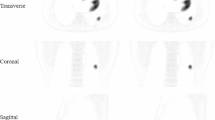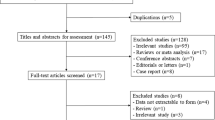Abstract
Purpose
The purpose of the study was to evaluate prospectively whether integrated 2-deoxy-2-[18F]fluoro-d-glucose positron emission tomography/computed tomography (FDG-PET/CT) is more accurate for determination of malignancy in newly diagnosed pulmonary lesions compared to separate interpretation of CT and FDG-PET.
Procedures
Two hundred and seventy-six patients with newly diagnosed lung lesions underwent FDG-PET/CT. Helical CT, FDG-PET, and FDG-PET/CT were interpreted separately to determine the performance of each imaging modality. Histopathology served as reference in all patients, and in further 60 patients, a benign lesion was verified at follow-up (mean follow-up of 1,040 days).
Results
Histology revealed malignant lung tumors in 216 of 276 patients. With PET and PET/CT, a significantly lower number of lesions were classified as equivocal compared to CT alone (p < 0.001). Assuming that equivocal lesions are benign, performance of diagnostic tests was as follows: sensitivity, specificity, and accuracy for CT was 94, 75, and 90%, for PET 97, 83, and 94% (p = 0.021), and for PET/CT 96, 87, and 94% (p = 0.010). Assuming that equivocal lesions are malignant, sensitivity, specificity, and accuracy for CT was 99, 37, and 86%, for PET 99, 77, and 94% (p < 0.001), and for PET/CT 98, 68, and 92% (p = 0.002). PET and PET/CT showed the highest concordance (K = 0.912; confidence interval 0.866–0.958). In lesions less than or equal to 3 cm, there was a significant difference in the performance of PET alone and multidetector row CT as well as PET/CT and multidetector row CT (p = 0.007), irrespective if equivocal findings were judged as malignant or benign.
Conclusion
For differentiation of benign from malignant lung lesions, integrated FDG-PET/CT imaging was significantly more accurate than CT but not FDG-PET. The addition of metabolic imaging (FDG-PET) to morphological imaging (CT) leads to an increase in specificity and significantly reduced equivocal findings and is therefore recommended to further specify newly diagnosed lung lesions.


Similar content being viewed by others
References
Brundage MD, Davies D, Mackillop WJ (2002) Prognostic factors in non-small cell lung cancer: a decade of progress. Chest 122:1037–1057
Naruke T, Goya T, Tsuchiya R, Suemasu K (1988) Prognosis and survival in resected lung carcinoma based on the new international staging system. J Thorac Cardiovasc Surg 96:440–447
Higashino T, Ohno Y, Takenaka D et al (2005) Thin-section multiplanar reformats from multidetector-row CT data: utility for assessment of regional tumor extent in non-small cell lung cancer. Eur J Radiol 56:48–55
Chooi WK, Matthews S, Bull MJ, Morcos SK (2005) Multislice computed tomography in staging lung cancer: the role of multiplanar image reconstruction. J Comput Assist Tomogr 29:357–360
Swensen SJ, Brown LR, Colby TV, Weaver AL, Midthun DE (1996) Lung nodule enhancement at CT: prospective findings. Radiology 201:447–455
Webb WR (2005) Lung cancer and bronchopulmonary neoplasms. In: Webb WR, Higgins CB (eds) Thoracic imaging. Lippincott Williams & Wilkins, Philadelphia
Pastorino U, Bellomi M, Landoni C et al (2003) Early lung-cancer detection with spiral CT and positron emission tomography in heavy smokers: 2-year results. Lancet 362:593–597
Gupta N, Gill H, Graeber G, Bishop H, Hurst J, Stephens T (1998) Dynamic positron emission tomography with F18 fluorodeoxyglucose imaging in differentiation of benign from malignant lung/mediastinallLesions. Chest 114:1105–1111
Hübner KF, Buonocore E, Gould HR et al (1996) Differentiating benign from malignant lung lesions using “quantitative” parameters of FDG PET images. Clin Nucl Med 37:943–948
Pieterman RM, van Putten JWG, Meuzelaar JJ et al (2000) Preoperative staging of non-small-cell lung cancer with 18-fluorodeoxyglucose positron-emission tomography. N Engl J Med 343:254–261
De Wever W, Ceyssens S, Mortelmans L et al (2007) Additional value of PET-CT in the staging of lung cancer: comparison with CT alone, PET alone and visual correlation of PET and CT. Eur Radiol 17:23–32
Pauls S, Buck AK, Hohl K et al (2007) Improved non-invasive T-staging in non-small cell lung cancer by integrated 18F-FDG PET/CT. Nuklearmedizin 46:9–14
Lardinois D, Weder W, Hany TF et al (2003) Staging of non-small-cell lung cancer with integrated positron-emission tomography and computed tomography. N Engl J Med 348:2500–2507
Shim SS, Lee KS, Kim B-T, Choi JY, Chung MJ, Lee EJ (2006) Focal parenchymal lung lesions showing a potential of false-positive and false-negative interpretations on integrated PET/CT. Am J Roentgenol 186:639–648
Webb WR (2005) Solitary and multiple nodules, masses, cavities, and cystes. In: Webb WR, Higgins CB (eds) Thoracic imaging. Lippincott Williams & Wilkins, Philadelphia
Von Schulthess GK, Steinert HC, Hany TF (2006) Integrated PET/CT: current applications and future directions. Radiology 238:405–422
Yi CA, Lee KS, Kim B-T et al (2006) Tissue characterization of solitary pulmonary nodule: comparative study between helical dynamic CT and integrated PET/CT. J Nucl Med 47:443–450
Antoch G, Freudenberg LS, Beyer T, Bockisch A, Debatin JF (2004) To enhance or not to enhance? 18F-FDG and CT contrast agents in dual-modality 18F-FDG PET/CT. J Nucl Med 45:56S–65S
Low S-Y, Eng P, Keng GHW, Ng DCE (2006) Positron emission tomography with CT in the evaluation of non-small cell lung cancer in populations with a high prevalence of tuberculosis. Respirology 11:84–89
Kim SK, Allen-Auerbach M, Goldin J et al (2007) Accuracy of PET/CT in characterization of solitary pulmonary lesions. J Nucl Med 48:214–220
Jeong YJ, Yi CA, Lee KS (2007) Solitary pulmonary nodules: detection, characterization, and guidance for further diagnostic workup and treatment. Am J Roentgenol 188:57–68
Truong MT, Erasmus JJ, Macapinlac HA et al (2005) Integrated positron emission tomography/computed tomography in patients with non-small cell lung cancer—normal variants and pitfalls. J Comput Assist Tomogr 29:205–209
Benard F, Sterman D, Smith RJ, Kaiser LR, Albelda SM, Alavi A (1998) Metabolic imaging of malignant pleural mesothelioma with fluorodeoxyglucose positron emission tomography. Chest 114:713–722
Bryant AS, Cerfolio RJ (2006) The maximum standardized uptake values on integrated FDG-PET/CT is useful in differentiating benign from malignant pulmonary nodules. Ann Thorac Surg. 82:1016–10220
Krüger S, Buck AK, Blumstein NM et al (2006) Use of integrated FDG PET/CT imaging in pulmonary carcinoid tumours. J Intern Med 260:545–550
Hashimoto Y, Tsujikawa T, Kondo C et al (2006) Accuray of PET for diagnosis of solid pulmonary lesions with 18F-FDG uptake below the standardized uptake value of 2.5. J Nucl Med 47:426–431
Lobrano MB, Hayman E, Dekelbaum M, Campeau R (2005) Biopsy findings in PET/CT-positive lung lesions in a community hospital. J La State Med Soc 157:319–324
Alkhawaldeh K, Bural G, Kumar R, Alavi A (2007) Impact of dual-time-point (18)F-FDG PET imaging and partial volume correction in the assessment of solitary pulmonary nodules. Eur J Nucl Med Mol Imaging (in press; Epub ahead of print; Oct 16 2007)
Nie Y, Li Q, Li F, Pu Y, Appelbaum D, Doi K (2006) Integrating PET and CT information to improve diagnostic accuracy for lung nodules: a semiautomatic computer-aided method. J Nucl Med 47:1075–1080
Author information
Authors and Affiliations
Corresponding author
Additional information
Sandra Pauls and Andreas K. Buck equally contributed.
An erratum to this article can be found at http://dx.doi.org/10.1007/s11307-008-0135-6
Rights and permissions
About this article
Cite this article
Pauls, S., Buck, A.K., Halter, G. et al. Performance of Integrated FDG-PET/CT for Differentiating Benign and Malignant Lung Lesions -Results from a Large Prospective Clinical Trial. Mol Imaging Biol 10, 121–128 (2008). https://doi.org/10.1007/s11307-007-0129-9
Received:
Revised:
Accepted:
Published:
Issue Date:
DOI: https://doi.org/10.1007/s11307-007-0129-9




